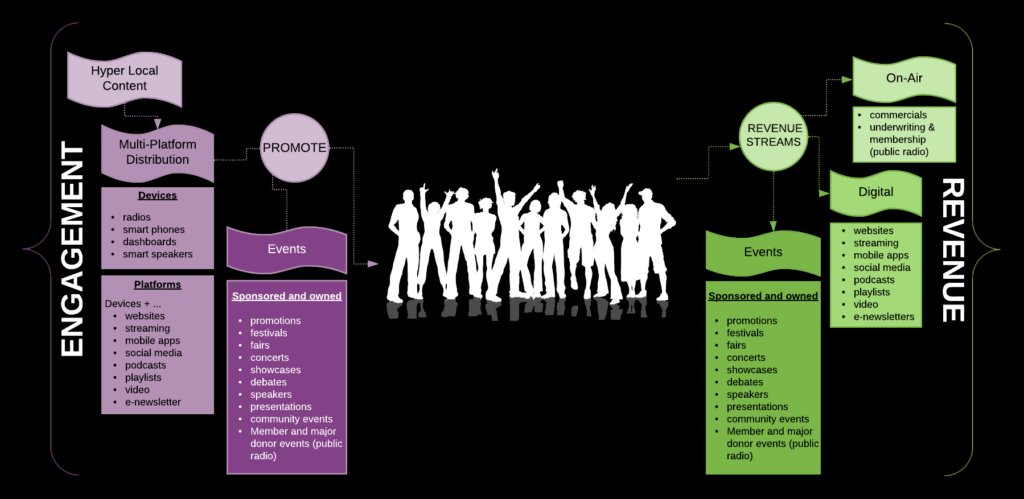Ten years ago, the rest of the country caught up with the economic stress that had defined the radio industry for several years prior: The economy stunk, and massive changes were needed for survival. The Great Recession of 2008 only put a nail in the coffin of radio’s old business model that had been on life support for at least five years prior to the national awakening. It was out of this realization that I first penned the “New Radio Model,” which postulated a new lifeline for radio based on the combination of hyper-local content with multi-platform distribution. Moving beyond spot buys and into position where radio could control its own pricing model, the New Radio Model would rely on monetization of live events and new digital revenue streams. The theory was that radio needed to evolve from mass media to a mass marketing by monetizing its vast promotional and distribution powers.
This is from my original 2009 New Radio Model: “The New Model leverages what radio does best: Create crowds through local promotions and live events, fueling many of the multiplatform revenue streams. The radio properties are the central mechanism in creating local multiplatform media marketing outlets.”

Fast-forwarding to 2019, it’s clear that radio has evolved in the way I envisioned. Event revenue is now a substantial component of many radio revenue budgets. From publicly-traded iHeartMedia’s massive music festivals to privately-owned Galaxy Communications in upstate New York’s innovative ownership of local festivals and promotion companies, there is real revenue moving through radio stations based on monetization of local events. Public radio also capitalizes on local event revenue with member events that pull-down huge income for one-night events, and smaller income for many smaller events through the year.
The monetization from digital distribution has exploded as consumer options for consuming original and re-purposed radio content have also exploded. Streaming, mobile apps, podcasts, playlists, satellite radio, social media, websites, smart speakers and video are just some of the ways in which local radio content now flows digitally and monetization follows. What new digital distribution points will we see in the next five years? In the next 10 years? The answers are unknown but the promise of new and un-envisioned ways of reaching consumers with content is real.
While commercial radio still struggles with hyper-local content, public (non-commercial) radio has built their entire business model around that point and enjoy growing listener-supported and local business revenue every year. Whether it comes from NPR News franchises with imbedded local content, the growing list of Music Discovery stations that lean heavily into “new, deep and local” music and have become drivers of local music economies, or even free-form community stations, public radio has seen its growth mushroom in the past 10 years.
Finally, radio’s incredible resilience continues to support radio as “the cockroach of all media.” You can’t kill it. According to Nielsen in 2018, 100 years after its debut, AM/FM radio continues to top the charts as the medium that reaches more consumers each week than any other medium. At 228.5 million consumers, each week more Americans tune into AM/FM radio (93%) than watch television, or use smartphones, tablets or computers. Radio’s 228.5 million weekly consumers is higher than the 216.5 million for TV (live, DVR and time-shifted), 203.8 million for app/web on a smartphone, and 127.6 million for video on a smartphone. Broadcast radio’s weekly reach of 228.5 million also outpaces the 68.5 million for streaming audio, 35.7 million using satellite radio and 21.9 million consuming podcasts.
Radio’s ability to innovate and evolve will be more critical in the next 10 years. No one knows what the future holds, but I wouldn’t bet against radio’s survival and even stronger bottom lines. The New Radio Model shows no signs of wearing thin, and in fact appears to provide an ongoing and viable path for local radio to follow for years to come.
The New Radio Model: 5 Years Later
Learn More about Mike Henry.

Leave A Comment